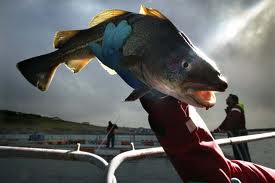Fresh fish has been our culinary safe haven. It is what we eat when we are feeling guilty about the food we actually enjoy eating. After all, fish are not shot up with hormones and quack science. What could be better than fresh fish from  the sea?
the sea?
Unfortunately, the National Academy of Sciences doesn;t quite see it that way. Fish, it turns out, are actually filters that swim. They pick up nearly everything we’ve been dumping in the world’s lakes and oceans for decades, stuff like industrial waste, harmful chemicals, and pesticides.
Don;t assume the government is inspecting the fish served at your favorite restaurant. Fish and shellfish are probably the only source of protein that are not inspected on a regular basis. In fact, the average fish processing plant is visited once every four years.
The restaurant industry and the supermarkets that sell fish are not particularly anxious to inform the consumer as to which fish are the safest and which tend to be the most dangerous. Let’s start with the most dangerous:
Ironically, so-called “freshwater” fish have the highest bacteria count. Whitefish from the Great Lakes are loaded with PCB’s and residues of DDT. Raw clams and the yellow part of Chesapeake Bay Crabs and their byproducts, along with the green tomalley found in fresh lobsters, are generally regarded as being too toxic for human consumption. Yet they are sold and plated in some of the nation;s best-known seafood restaurants.
On e of ther facts that has escaped the public is the growing threat from fish that swim in the oceans. These fish have been showing up with increasing levels of scombroid or ciguatera bacteria that are not killed in the cooking process. Currently, the worst of these are Grouper, Barracuda, Amber jack, and the several varieties of fake “Snappers” found in tropical waters.
Another gourmet fish that has a better reputation than it deserves is the Swordfish. Methyl Mercury poisoning has been found in Swordfish with such regularity that the National Academy of Sciences was moved to recommend that couples contemplating childbirth avoid the species.
We won’t even discuss the single most dangerous category of fish, molluskan shellfish, or your basic Oysters, Mussels, and Clams.
It must be said that better restaurants today carefully check their sources and most restaurant fish is safe. The safest and most chemical-free fish tend to live in deep waters, far offshore and are, therefore, often more difficult to fish. The species that should be trusted include Cod, Haddock. Mahi-Mahi and Salmon are almost always safe unless they are fished from the Great Lakes.
Supermarket fish pose the most dangers. In many parts of the world, consumers would never consider buying a fish whose head and gills are missing. A trained fish grocer can trim a fish that is well past its prime and still make it look attractive and, even fresh. To avoid disappointing fish in traditional supermarket chains, some savvy consumers now purchase their fish whole from the fish department at their local oriental market. Local customers are usually willing to help the uninitiated spot the freshest of the fresh.
The food industry has confused the public to such a degree that few of us could accurately answer the question:
“Which food is likely the most dangerous to the average American – Meat, Chicken, or Fish?”
Sadly, you could argue that one three ways. But don’t rule out fish as the answer.
